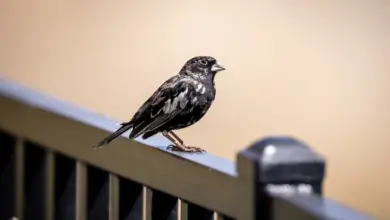Northern Fowl Mites
| Mites that Feed off Humans Treatment Options and Useful Web Resources and Forums Related News Articles / Videos Dealing with Infected Pet Birds (also provides good information applicable for human and pet treatment) |
Northern fowl mites are accidental pests to humans. The adult, female, fowl mite lays eggs on the host. The eggs hatch in 1-2 days into the six-legged larval stage which does not feed. The larvae molt to the nymphal stage in about eight hours. The nymphs and adults have piercing mouthparts and seek blood meals. The complete life cycle from egg to egg-laying adult can take from five to seven days or longer, depending on the environment.
They may migrate from bird nests in eaves, rafters, or gutters into homes once the chicks (their preferred hosts) are no longer available. This could be because the young have fledged the nest or the birds have been scared off / denied access to the nest, forcing mites to search for new hosts.
Relevant Research about Treatment Options:
TITLE: Susceptibilities of northern fowl mite, Ornithonyssus sylviarum (Acarina: Macronyssidae), and chicken mite, Dermanyssus gallinae (Acarina: Dermanyssidae), to selected acaricides.
JOURNAL/DATE: Exp Appl Acarol. 1991 Dec;13(2):137-42
AUTHOR(S): Fletcher MG, et al.
ABSTRACT/SUMMARY: The relative toxicities of ten acaricides to northern fowl mite, Ornithonyssus sylviarum (Canestrini and Fanzago), and the chicken mite, Dermanyssus gallinae (De Geer), were determined simultaneously by holding the mites inside disposable glass Pasteur pipettes previously immersed in acetone solutions of various concentrations (w/v) of technical grade acaricides. The LC90s (parts per million) of the acaricides after 24 h exposure for the northern fowl mite and the chicken mite, respectively, were: bendiocarb (13.1, 0.18), tetrachlorvinphos (14.5, 4.07), carbaryl (15.0, 0.83), pirimiphos methyl (18.3, 2.03), permethrin (23.1, 8.46), lambda-cyhalothrin (80.7, 11.4), dichlorvos (252.8, 3.75), malathion (238.4, 6.59), amitraz (6741, 9430) and fenvalerate (greater than 10,000, 60.2). After 48 h exposure, there were only slight increases in mortalities of both species except for increased mortalities for the northern fowl mite with lambda-cyhalothrin, amitraz, and fenvalerate, and for the chicken mite with amitraz.
IMPLICATIONS: Fenvalerate is a fairly effective miticide, but it is no longer available. It has been replaced with Esfenvalerate. Keep in mind that miticides have to directly contact mites to be effective; there is very little vapor effect that will produce good results. Most OTC bug sprays are of such low concentrations of active ingredients as to not be effective. However, a PCO would have access to stronger chemical solutions. Some OTC bug sprays will state that they will kill for three months or so. That may be for roaches and ants, but it is not applicable to mites.
TITLE: Acaricide Resistance in Northern Fowl Mite (Ornithonyssus sylviarum) Populations on Caged Layer Operations in Southern California
JOURNAL/DATE: Poult Sci. 2004 Mar;83(3):365-74.
AUTHOR(S): Mullens BA, Velten RK, Hinkle NC, Kuney DR, Szijj CE., Department of Entomology, University of California Cooperative Extension
ABSTRACT/SUMMARY: Southern California caged layer operations were visited over 3 yr. Northern fowl mites from 26 field populations were tested for acaricide resistance using a capillary pipette and glass dish bioassay. One was a susceptible field population with no pesticide exposure for over 30 yr (reference site for resistance ratio calculation). Technical and commercial formulations of malathion, carbaryl (Sevin), permethrin, and a commercial formulation of tetrachlorvinphos/dichlorvos (Ravap) were tested. Malathion did not have high activity for mites relative to other materials, but resistance to both technical and commercial formulations was low (< 5x). Resistance to other materials was moderate to extreme. Frequency of carbaryl resistance (> 10x) was higher with the commercial (88%) than the technical material (41%); 19% of the populations had resistance > 100x to commercial carbaryl. Frequency of Ravap resistance (> 10x) was 68%; 8% of populations had resistance > 100x.
Frequency of permethrin resistance (> 10x) was 72% for the technical material and 88% for the commercial formulation. Extreme permethrin resistance (> 1,000x) was observed in 56 and 50% of mite populations assayed using the technical and commercial formulations, respectively. Among sites, resistance to permethrin was uncorrelated with resistance to other chemicals, suggesting a different resistance mechanism. Resistance to carbaryl and Ravap was highly correlated [r = 0.76 at the LC50 level (concentrations estimated to be lethal to 50% of the test population) and r = 0.99 at the LC95 level], suggesting a common resistance mechanism. Producers currently depend completely on pesticides to control mite infestations. Mite resistance to registered materials emphasizes the need for integrated control measures.
IMPLICATIONS: Research that further demonstrates how ineffective the pyrethrin and permethrin-based chemicals are against bird mites. It is important that the PCO be aware of these facts before treating the home.




